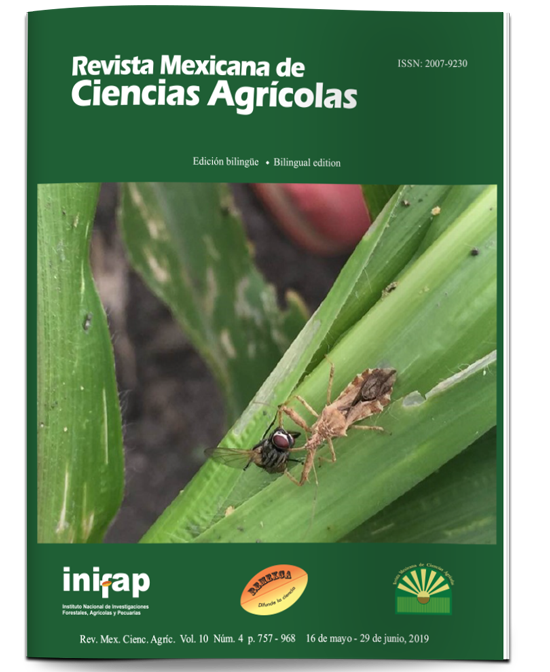Fungi associated with the regressive death of citrus fruits in Nuevo Leon and Tamaulipas, Mexico
DOI:
https://doi.org/10.29312/remexca.v10i4.1417Keywords:
Lasiodiplodia, pathogenicity, phytopathogenic fungiAbstract
The cultivation of citrus fruits is affected by several phytopathogenic fungi, which can cause diseases and reduce their production. The fungus Lasiodiplodia spp. causes regressive death and other symptoms in citrus and other crops in various countries, including Mexico. The objective of this work was to identify isolated fungal strains of citrus trees with symptoms of regressive death and to evaluate their pathogenicity in greenhouse conditions. The isolated fungi were identified based on their morphological characteristics such as Lasiodiplodia theobromae, Fomitopsis meliae and Eutypella citricola, confirmed with PCR amplification and sequencing of the ITS region when compared to the GenBank sequences. In the greenhouse bioassay, it was found that L. theobromae and F. meliae cause symptoms of wilting, descending death and necrotic lesions in the inoculated areas from the fourth day after inoculation in plants of sweet orange variety Valencia. F. meliae + L. theobromae caused more severe damage, causing necrotic lesions of 22 to 27 cm in length, wilt and regressive death and both were reisolated from the lesions produced. E. citricola only produced necrosis around the inoculated area. According to the results of the pathogenicity test, fungi L. theobromae and F. meliae cause regressive citrus death.
Downloads
Downloads
Published
How to Cite
Issue
Section
License
The authors who publish in Revista Mexicana de Ciencias Agrícolas accept the following conditions:
In accordance with copyright laws, Revista Mexicana de Ciencias Agrícolas recognizes and respects the authors’ moral right and ownership of property rights which will be transferred to the journal for dissemination in open access. Invariably, all the authors have to sign a letter of transfer of property rights and of originality of the article to Instituto Nacional de Investigaciones Forestales, Agrícolas y Pecuarias (INIFAP) [National Institute of Forestry, Agricultural and Livestock Research]. The author(s) must pay a fee for the reception of articles before proceeding to editorial review.
All the texts published by Revista Mexicana de Ciencias Agrícolas —with no exception— are distributed under a Creative Commons License Attribution-NonCommercial 4.0 International (CC BY-NC 4.0), which allows third parties to use the publication as long as the work’s authorship and its first publication in this journal are mentioned.
The author(s) can enter into independent and additional contractual agreements for the nonexclusive distribution of the version of the article published in Revista Mexicana de Ciencias Agrícolas (for example include it into an institutional repository or publish it in a book) as long as it is clearly and explicitly indicated that the work was published for the first time in Revista Mexicana de Ciencias Agrícolas.
For all the above, the authors shall send the Letter-transfer of Property Rights for the first publication duly filled in and signed by the author(s). This form must be sent as a PDF file to: revista_atm@yahoo.com.mx; cienciasagricola@inifap.gob.mx; remexca2017@gmail.
This work is licensed under a Creative Commons Attribution-Noncommercial 4.0 International license.



